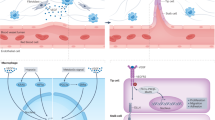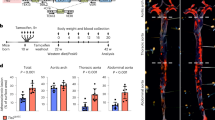Abstract
The therapeutic potential of placental growth factor (PlGF) and its receptor Flt1 in angiogenesis is poorly understood. Here, we report that PlGF stimulated angiogenesis and collateral growth in ischemic heart and limb with at least a comparable efficiency to vascular endothelial growth factor (VEGF). An antibody against Flt1 suppressed neovascularization in tumors and ischemic retina, and angiogenesis and inflammatory joint destruction in autoimmune arthritis. Anti-Flt1 also reduced atherosclerotic plaque growth and vulnerability, but the atheroprotective effect was not attributable to reduced plaque neovascularization. Inhibition of VEGF receptor Flk1 did not affect arthritis or atherosclerosis, indicating that inhibition of Flk1-driven angiogenesis alone was not sufficient to halt disease progression. The anti-inflammatory effects of anti-Flt1 were attributable to reduced mobilization of bone marrow–derived myeloid progenitors into the peripheral blood; impaired infiltration of Flt1-expressing leukocytes in inflamed tissues; and defective activation of myeloid cells. Thus, PlGF and Flt1 constitute potential candidates for therapeutic modulation of angiogenesis and inflammation.
This is a preview of subscription content, access via your institution
Access options
Subscribe to this journal
Receive 12 print issues and online access
$209.00 per year
only $17.42 per issue
Buy this article
- Purchase on Springer Link
- Instant access to full article PDF
Prices may be subject to local taxes which are calculated during checkout




Similar content being viewed by others
References
Ferrara, N. Role of vascular endothelial growth factor in regulation of physiological angiogenesis. Am. J. Physiol. Cell. Physiol. 280, C1358–C1366 (2001).
Post, M.J., Laham, R., Sellke, F.W. & Simons, M. Therapeutic angiogenesis in cardiology using protein formulations. Cardiovasc Res. 49, 522–531 (2001).
Isner, J.M. Myocardial gene therapy. Nature 415, 234–239 (2002).
Carmeliet, P. & Jain, R.K. Angiogenesis in cancer and other diseases. Nature 407, 249–257 (2000).
Veikkola, T., Karkkainen, M., Claesson-Welsh, L. & Alitalo, K. Regulation of angiogenesis via vascular endothelial growth factor receptors. Cancer Res. 60, 203–212 (2000).
Hiratsuka, S., Minowa, O., Kuno, J., Noda, T. & Shibuya, M. Flt-1 lacking the tyrosine kinase domain is sufficient for normal development and angiogenesis in mice. Proc. Natl. Acad. Sci. USA 95, 9349–9354 (1998).
Shibuya, M. Structure and function of VEGF/VEGF-receptor system involved in angiogenesis. Cell Struct. Funct. 26, 25–35 (2001).
Persico, M.G., Vincenti, V. & DiPalma, T. Structure, expression and receptor-binding properties of placenta growth factor (PlGF). Curr. Top. Microbiol. Immunol. 237, 31–40 (1999).
Fong, G.H., Rossant, J., Gertsenstein, M. & Breitman, M.L. Role of the Flt-1 receptor tyrosine kinase in regulating the assembly of vascular endothelium. Nature 376, 66–70 (1995).
Park, J.E., Chen, H.H., Winer, J., Houck, K.A. & Ferrara, N. Placenta growth factor. Potentiation of vascular endothelial growth factor bioactivity, in vitro and in vivo, and high affinity binding to Flt-1 but not to Flk-1/KDR. J. Biol. Chem. 269, 25646–25654 (1994).
Carmeliet, P. et al. Synergism between vascular endothelial growth factor and placental growth factor contributes to angiogenesis and plasma extravasation in pathological conditions. Nature Med. 7, 575–583 (2001).
Hiratsuka, S. et al. Involvement of Flt-1 tyrosine kinase (vascular endothelial growth factor receptor-1) in pathological angiogenesis. Cancer Res. 61, 1207–1213 (2001).
Weng, D.E. & Usman, N. Angiozyme: a novel angiogenesis inhibitor. Curr. Oncol. Rep. 3, 141–146 (2001).
Ishida, A. et al. Expression of vascular endothelial growth factor receptors in smooth muscle cells. J. Cell. Physiol. 188, 359–368 (2001).
Carmeliet, P. Mechanisms of angiogenesis and arteriogenesis. Nature Med. 6, 389–395 (2000).
van Royen, N. et al. Stimulation of arteriogenesis; a new concept for the treatment of arterial occlusive disease. Cardiovasc. Res. 49, 543–553 (2001).
Arras, M. et al. Monocyte activation in angiogenesis and collateral growth in the rabbit hindlimb. J. Clin. Invest. 101, 40–50 (1998).
Hoefer, I.E., van Royen, N., Buschmann, I.R., Piek, J.J. & Schaper, W. Time course of arteriogenesis following femoral artery occlusion in the rabbit. Cardiovasc. Res. 49, 609–617 (2001).
Pettersson, A. et al. Heterogeneity of the angiogenic response induced in different normal adult tissues by vascular permeability factor/vascular endothelial growth factor. Lab. Invest. 80, 99–115 (2000).
Dvorak, H.F., Dvorak, A.M., Manseau, E.J., Wiberg, L. & Churchill, W.H. Fibrin gel investment associated with line 1 and line 10 solid tumor growth, angiogenesis, and fibroplasia in guinea pigs Role of cellular immunity, myofibroblasts, microvascular damage, and infarction in line 1 tumor regression. J. Natl. Cancer Inst. 62, 1459–1472 (1979).
McLeod, D.S. et al. Localization of VEGF receptor-2 (KDR/Flk-1) and effects of blocking it in oxygen-induced retinopathy. Invest. Ophthalmol. Vis. Sci. 43, 474–482 (2002).
Celletti, F.L. et al. Vascular endothelial growth factor enhances atherosclerotic plaque progression. Nature Med. 7, 425–429 (2001).
Moulton, K.S. Plaque angiogenesis and atherosclerosis. Curr. Atheroscler. Rep. 3, 225–233 (2001).
Lee, D.M. & Weinblatt, M.E. Rheumatoid arthritis. Lancet 358, 903–911 (2001).
Weber, A.J. & De Bandt, M. Angiogenesis: general mechanisms and implications for rheumatoid arthritis. Joint Bone Spine 67, 366–383 (2000).
Miotla, J., Maciewicz, R., Kendrew, J., Feldmann, M. & Paleolog, E. Treatment with soluble VEGF receptor reduces disease severity in murine collagen-induced arthritis. Lab. Invest. 80, 1195–1205 (2000).
Sone, H. et al. Neutralization of vascular endothelial growth factor prevents collagen-induced arthritis and ameliorates established disease in mice. Biochem. Biophys. Res. Commun. 281, 562–568 (2001).
Courtenay, J.S., Dallman, M.J., Dayan, A.D., Martin, A. & Mosedale, B. Immunisation against heterologous type II collagen induces arthritis in mice. Nature 283, 666–668 (1980).
Folkman, J. Angiogenesis-dependent diseases. Semin. Oncol. 28, 536–542 (2001).
Bottomley, M.J. et al. Placenta growth factor (PlGF) induces vascular endothelial growth factor (VEGF) secretion from mononuclear cells and is co-expressed with VEGF in synovial fluid. Clin. Exp. Immunol. 119, 182–188 (2000).
Lyden, D. et al. Impaired recruitment of bone-marrow-derived endothelial and hematopoietic precursor cells blocks tumor angiogenesis and growth. Nature Med. 7, 1194–1201 (2001).
Riessen, R., Kearney, M., Lawler, J. & Isner, J.M. Immunolocalization of thrombospondin-1 in human atherosclerotic and restenotic arteries. Am. Heart J. 135, 357–364 (1998).
Carmeliet, P. VEGF gene therapy: stimulating angiogenesis or angioma-genesis?. Nature Med. 6, 1102–1103 (2000).
Lazarous, D.F. et al. Basic fibroblast growth factor in patients with intermittent claudication: results of a phase I trial. J. Am. Coll. Cardiol. 36, 1239–1244 (2000).
Hattori, K. et al. Placental growth factor reconstitutes hematopoiesis by recruiting VEGFR1+ stem cells from bone-marrow microenvironment. Nature Med. 8, advance online publication, 1 July 2002 (doi:10.1038/nm740).
Sawano, A. et al. Flt-1, vascular endothelial growth factor receptor 1, is a novel cell surface marker for the lineage of monocyte-macrophages in humans. Blood 97, 785–791 (2001).
Clauss, M. Functions of the VEGF receptor-1 (FLT-1) in the vasculature. Trends Cardiovasc. Med. 8, 241–245 (1998).
Brenchley, P.E. Angiogenesis in inflammatory joint disease: a target for therapeutic intervention. Clin. Exp. Immunol. 121, 426–429 (2000).
Libby, P. What have we learned about the biology of atherosclerosis? The role of inflammation. Am. J. Cardiol. 88, 3J–6J (2001).
Lutgens, E. et al. Both early and delayed anti-CD40L antibody treatment induces a stable plaque phenotype. Proc. Natl. Acad. Sci. USA 97, 7464–7469 (2000).
Simons, M. et al. Clinical trials in coronary angiogenesis: issues, problems, consensus: an expert panel summary. Circulation 102, E73–E86 (2000).
Witte, L. et al. Monoclonal antibodies targeting the VEGF receptor-2 (Flk1/KDR) as an anti-angiogenic therapeutic strategy. Cancer Metastasis Rev. 17, 155–161 (1998).
Luttun, A. et al. Lack of plasminogen activator inhibitor-1 promotes growth and abnormal matrix remodeling of advanced atherosclerotic plaques in apolipoprotein-deficient mice. Arterioscler. Thromb. Vasc. Biol. 22, 499–505 (2002).
Matthys, P. et al. Enhanced autoimmune arthritis in IFN-γ receptor-deficient mice is conditioned by mycobacteria in Freund's adjuvant and by increased expansion of Mac-1+ myeloid cells. J. Immunol. 163, 3503–3510 (1999).
Matthys, P. et al. Anti-IL-12 antibody prevents the development and progression of collagen-induced arthritis in IFN-γ receptor-deficient mice. Eur. J. Immunol. 28, 2143–2151 (1998).
Priller, J. et al. Targeting gene-modified hematopoietic cells to the central nervous system: use of green fluorescent protein uncovers microglial engraftment. Nature Med. 7, 1356–1361 (2001).
Couffinhal, T. et al. Mouse model of angiogenesis. Am. J. Pathol. 152, 1667–1679 (1998).
Matsumoto, K., Ishihara, K., Tanaka, K., Inoue, K. & Fushiki, T. An adjustable-current swimming pool for the evaluation of endurance capacity of mice. J. Appl. Physiol. 81, 1843–1849 (1996).
Carmeliet, P. et al. Impaired myocardial angiogenesis and ischemic cardiomyopathy in mice lacking the vascular endothelial growth factor isoforms VEGF164 and VEGF188. Nature Med. 5, 495–502 (1999).
Acknowledgements
We thank A. Bouché, K. Vandevelde, Y. Wing Man, I. Vanlinthout, M. De Mol, K. Maris, B. Vanwetswinkel, A. Manderveld, B. Hermans, P. Van Wesemael, S. Jansen, W. Martens, A. Vandenhoeck, S. Terclavers, S. Wyns, W. Landuyt and S. Torrekens for assistance. This work was supported in part by the European Union (Biomed BMH4-CT98-3380), Actie Levenslijn (#7.0019.98), FWO (G012500 and G032401) and a KUL/OT grant (TBA/00/27). A.L. and V.C. are FWO research fellows. M.T. is an IWT research fellow.
Author information
Authors and Affiliations
Corresponding author
Ethics declarations
Competing interests
The anti-Flt1 monoclonal antibody was generated by ImClone Systems Inc. Y.W., F.L., A.H., P.B. and D. Hicklin are employed by ImClone. D.C. is employed by ThrombX; the center for Transgene Technology as received support from ThrombX for the research program evaluating the therapeutic potential of PlGF for heart and limb ischemia.
Supplementary information
Rights and permissions
About this article
Cite this article
Luttun, A., Tjwa, M., Moons, L. et al. Revascularization of ischemic tissues by PlGF treatment, and inhibition of tumor angiogenesis, arthritis and atherosclerosis by anti-Flt1. Nat Med 8, 831–840 (2002). https://doi.org/10.1038/nm731
Received:
Accepted:
Published:
Issue Date:
DOI: https://doi.org/10.1038/nm731
This article is cited by
-
Tissue factor (coagulation factor III): a potential double-edge molecule to be targeted and re-targeted toward cancer
Biomarker Research (2023)
-
Angiogenic signaling pathways and anti-angiogenic therapy for cancer
Signal Transduction and Targeted Therapy (2023)
-
Placental growth factor exerts a dual function for cardiomyogenesis and vasculogenesis during heart development
Nature Communications (2023)
-
Chemerin regulates normal angiogenesis and hypoxia-driven neovascularization
Angiogenesis (2022)
-
Coordinated interactions between endothelial cells and macrophages in the islet microenvironment promote β cell regeneration
npj Regenerative Medicine (2021)



